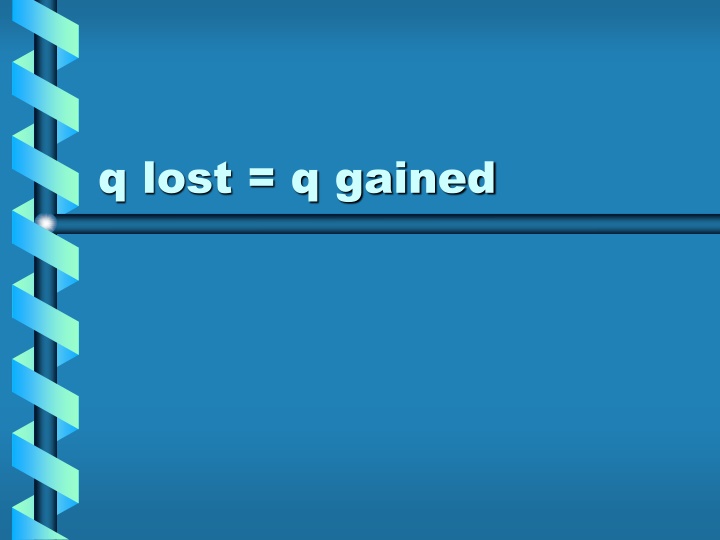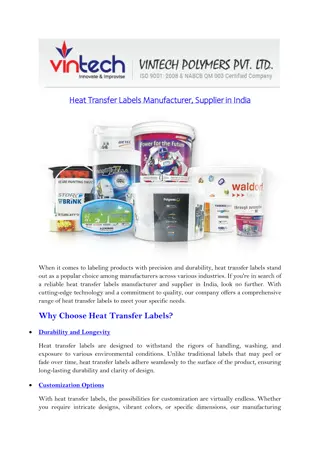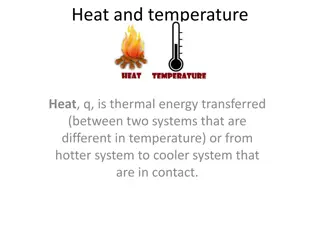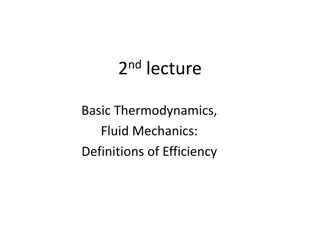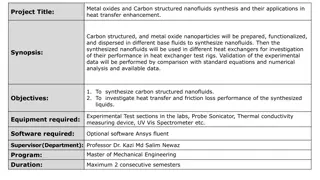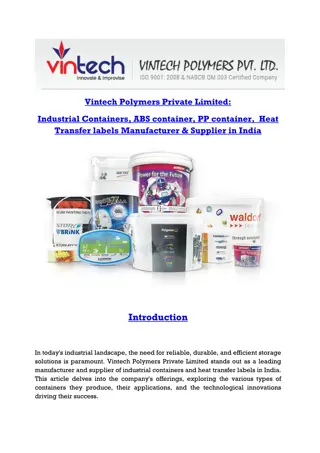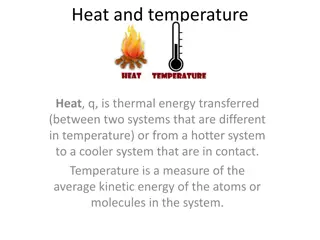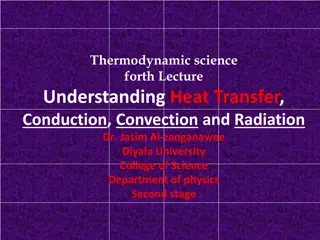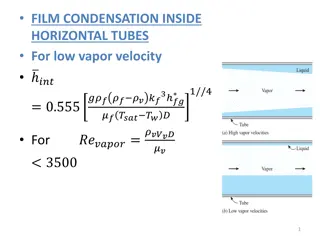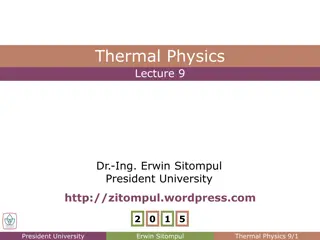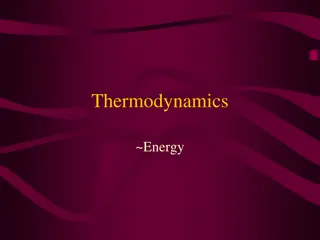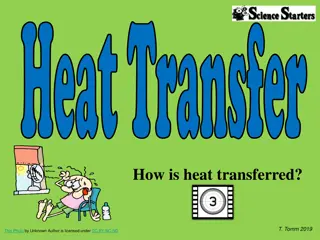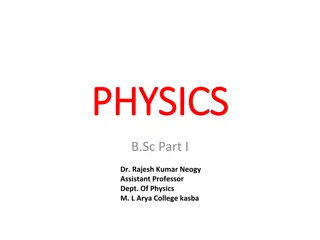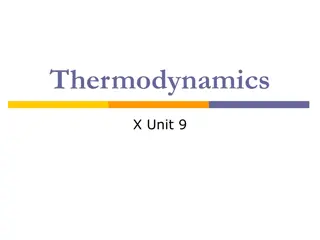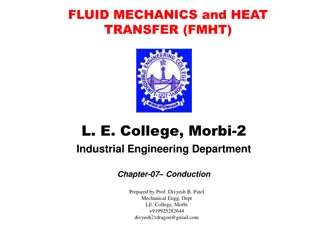Problems in Thermodynamics: Solving Heat Transfer Scenarios
Explore various heat transfer scenarios involving cooling objects, energy conservation, and equilibration of temperature between different substances like water, tungsten, and metals. Learn how to calculate heat lost or gained in each situation while applying the principles of the first law of thermodynamics.
Download Presentation

Please find below an Image/Link to download the presentation.
The content on the website is provided AS IS for your information and personal use only. It may not be sold, licensed, or shared on other websites without obtaining consent from the author.If you encounter any issues during the download, it is possible that the publisher has removed the file from their server.
You are allowed to download the files provided on this website for personal or commercial use, subject to the condition that they are used lawfully. All files are the property of their respective owners.
The content on the website is provided AS IS for your information and personal use only. It may not be sold, licensed, or shared on other websites without obtaining consent from the author.
E N D
Presentation Transcript
Cooling object 7.2 mol of H2gas is cooled from 319 K to 299K, how much heat was lost? q = nC T
Cooling object 7.2 mol of H2gas is cooled from 319 K to 299K, how much heat was lost? q = nC T q = 7.2mol (28.8J/molK)(299-319K) q = -4147.2 J q = -4100 J 4.1 kJ was lost negative means the energy was lost instead of gained.
Energy is never destroyed!!! 1stlaw of thermodynamics In a closed system, if you put 2 objects of different temperatures together the heat will go from the hotter object to the cooler object. the q lost by one object will be the q gained by the other object. q lost= q gained
continuing with the H2 from the earlier problem The hydrogen was put in 9.179 moles of a substance at 274.4 K and it heated to 280.4 K, what was the substance? q lost= 4147.2 J 4147.2 = 9.179 mol C (6.0K) C = 75 J/K mol water (liquid)
Another problem .778 mol of tungsten at 68oC is dropped in water at 25oC, the system comes to equilibrium (both temperatures are equal) at 35oC. How much water was present?
Another problem .778 mol of tungsten at 68oC is dropped in water at 25oC, the system comes to equilibrium (both temperatures are equal) at 35oC. How much water was present? q lost= .778 mol(24.2)(-33) = -621 = 621.3108 = n (75.3)(10) n = .83 mol H2O
A problem You add 14.2 g of a metal at 98.0oC to 126 g of water at 17.2o C. The system comes to equilibrium at 19.1oC. What is the metal? qlost m c T Tf Ti qgained m c T Tf Ti
A problem You add 14.2 g of a metal at 98.0o C to 126 g of water at 17.2o C. The system comes to equilibrium at 19.1o C. What is the metal? qlost m c T Tf Ti 98.0o C qgained m c T Tf Ti 126 g 4.183 1.9 K 19.1o C 17.2o C 14.2 g ? -78.9 K 19.1o C
Work q = m c T Water side q = 126 g (4.183) 1.9K = 1001.4102 J = -1001.4102 J lost -1001 = 14.2 g (c) -78.9 K c = .89 J/g K Most likely aluminum. How close your answer is to the actual answer depends on how good your lab technique is.
A different problem You add 63 g of a metal at 101.0o C to 132 g of water at 19.0o C. The system comes to equilibrium at 20.2o C. What is the metal? qlost m c T Tf Ti Ti qgained m c T Tf
A different problem You add 63 g of a metal at 101.0o C to 132 g of water at 19.0o C. The system comes to equilibrium at 20.2o C. What is the metal? qlost m c T Tf Ti Ti qgained m c T Tf 63 g ? -80.8 20.2 o C 101.0 o C 132 g 4.183 1.2 20.2o C 19.0o C
Work q = m c T Water side q = 132 g (4.183) 1.2K = 662.5872 J = -662.5872 J lost -662 = 63 g (c) -80.8 K c = .13 J/g K Either lead or gold. Check for color to determine which
Another 5.25 mol of He at 34o C is mixed with 24.3 mol of H2 and the system comes to equilibrium at 14o C, what was the initial temperature of the hydrogen?
Another 5.25 mol of He at 34o C is mixed with 24.3 mol of H2 and the system comes to equilibrium at 14o C, what was the initial temperature of the hydrogen? q lost He = 5.25 mol(25.2)(287-307) q lost He = -2646 J 2646 J = 24.3 mol(28.8) (287- Ti H2) Ti H2 = 283 K (10.o C)
More 23 g of nickel at 99.8o C is dropped in 121 g of water at 20.3o C. What is the final temperature?
More 23 g of nickel at 99.8o C is dropped in 121 g of water at 20.3o C. What is the final temperature? -23g(.444)(99.9-Tf) =121g(4.183)(20.3-Tf) Tf = 21.8o C
Problems 2.28 mol of aluminum at 66.0o C is dropped in water at 28.0o C, the system comes to equilibrium (both temperatures are equal) at 34.0o C, how much water was present?
Problems 2.28 mol of aluminum at 66.0o C is dropped in water at 28.0o C, the system comes to equilibrium (both temperatures are equal) at 34.0o C, how much water was present? q lost = 2.28 mol(24.2)(-32) = -1765.632 = -(n (75.3)(6.0)) n = 3.9 mol H2O
Last One How many grams of silver at 50o C would be required to heat 21 mol of water from 12o C to 32o C (bring the system at equilibrium at 32o C)?
Last One How many grams of silver at 50o C would be required to heat 21 mol of water from 12o C to 32o C (bring the system at equilibrium at 32o C)? q = 21 mol(75.3)(20K) = 31626 J q = - 31626 J = m (.233) (-18) m = 7500 g or 7.5 kg
